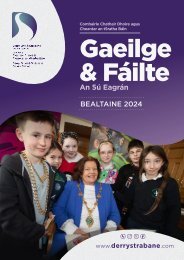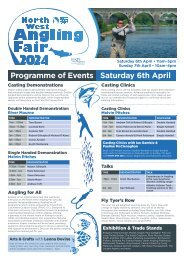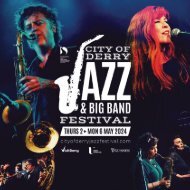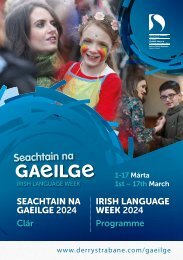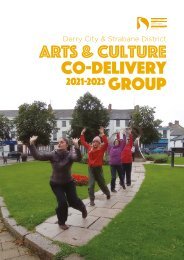Derry & Strabane: Natural Capital Report of Outdoor Recreation Spaces 2021
An analysis of the true social, health, economic and environmental value of green and blue spaces in our District using Natural Capital Accounting.
An analysis of the true social, health, economic and environmental value of green and blue spaces in our District using Natural Capital Accounting.
Create successful ePaper yourself
Turn your PDF publications into a flip-book with our unique Google optimized e-Paper software.
Methodology annex<br />
4<br />
Figure 7: Physical health value is estimated based on the activity levels <strong>of</strong> visitors to greenspaces in the<br />
UK<br />
Inactive Low activity High activity<br />
4%<br />
<strong>of</strong> visitors do not get any<br />
physical health benefits<br />
from activity in parks<br />
66%<br />
<strong>of</strong> visitors undertake low<br />
levels <strong>of</strong> activity in parks,<br />
leading to reduced risks <strong>of</strong><br />
mortality<br />
30%<br />
<strong>of</strong> visitors undertake high<br />
levels <strong>of</strong> activity in parks<br />
and have active lifestyles,<br />
leading to higher quality<br />
and longer lives<br />
+£500 +£1500<br />
£0 £500 £2000<br />
Source: Vivid Economics based on MENE survey data<br />
Amenity (recreational) value measures people’s preferences for living closer to green spaces, which is<br />
expressed by their willingness to pay in the housing market. The uplift value is estimated for properties<br />
located within 200m <strong>of</strong> greenspaces. The uplift value coefficients are based on the hedonic pricing model<br />
from the ONS and are annualized over 30 years at 3.5% discount rate.<br />
Carbon sequestration methodology estimates the value <strong>of</strong> captured carbon. The first step is looking at the<br />
tree capture and storage <strong>of</strong> atmospheric carbon dioxide (CO2). Each ton <strong>of</strong> CO2 sequestered prevents future<br />
damage by projected climate change. Secondly, tree canopy cover (as estimated by the Council) within<br />
greenspaces is used to estimate the amount <strong>of</strong> carbon sequestered and valued using the price <strong>of</strong> untraded<br />
carbon from the HM Treasury Green Book. Carbon sequestration is estimated by assuming an average rate<br />
<strong>of</strong> carbon sequestration per hectare <strong>of</strong> trees <strong>of</strong> 5.4 tons <strong>of</strong> carbon dioxide (CO2) per year (ONS, 2017). The<br />
price <strong>of</strong> one untraded ton <strong>of</strong> CO2 in 2019 is £68. As a result, the value <strong>of</strong> carbon sequestration is a product <strong>of</strong><br />
the annual carbon price and the total annual sequestration from the trees in a greenspace.<br />
21







